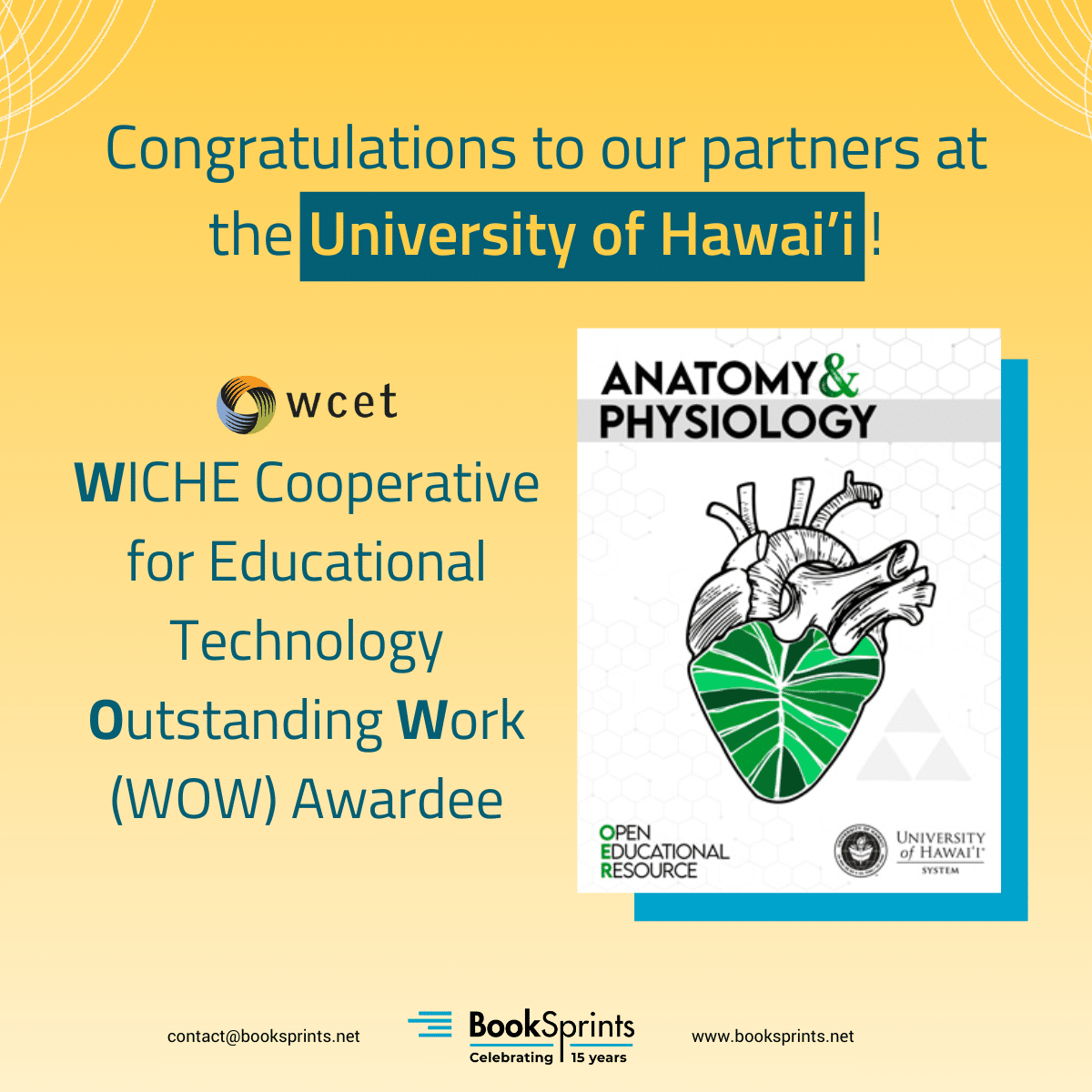What Happened to the Book: Anatomy & Physiology OER Textbook with University of Hawai’i
Almost 4 years ago, in March 2021, we held a virtual Book Sprint with a team of 10 faculty members from the University of Hawai’i’s many campuses to write an Anatomy and Physiology OER textbook. This was the first virtual Book Sprint with the university after two successful Sprints in 2019.
The Anatomy and Physiology textbook is part of an OER textbook series published by the University of Hawaii at Manoa to drastically reduce the cost of learning materials for its students across the islands. At the same time, with the freedom to build on existing OER, instructors can create content that fits their own teaching style and the needs of their students.
Rewarding Accessibility, Inclusivity, and Community

Recently, this Anatomy and Physiology OER textbook won the WICHE Cooperative for Educational Technology Outstanding Work (WOW) Award! The WOW award recognizes outstanding efforts to apply innovative solutions to a challenging educational need. There are several innovative solutions that the authors of the Sprint included in the Anatomy and Physiology (A&P) OER textbook, namely with regards to accessibility, inclusivity, and community.
Accessibility
According to the University of Hawai’i, over 4,000 students across 10 campuses spend over $400,000 yearly on books for their A&P classes. This A&P OER textbook is available for free online — a potential game changer for students who found the cost of the book prohibitive. Students, especially those from marginalized populations, now have the opportunity to access the comprehensive material without the usual $200 price tag. This is a huge, incredibly important step forward in increasing accessibility not only of the book, but also the A&P course and the pathway to medicine as a career.
It is admirable how the faculty members recognized their students’ needs and found an innovative solution for it. They recognized that students experienced financial barriers with purchasing these books, some of them either getting it delayed or never being able to get it at all. This zero-cost OER textbook could truly help thousands of students for cohorts to come.
Inclusivity
Another student need these faculty members recognized was how valuable it would be to their learning experience to see themselves in the material they were studying. Thus, this A&P OER textbook was designed to be culturally responsive and contain localized content. The anatomy and physiology content is situated in the local context, history, society, and ecology of the Hawai’ian islands. Thus, woven into the text are information on local health issues, food, environment, and common problems affecting the native Hawai’ian communities. In a blog post on the book, textbook co-author Jason Kenji Higa explained, “We hope that by seeing themselves and others in the textbook, students will experience and express empathy, interest in learning about each other, and form a diverse social network during their academic journey.”
One advantage of the textbook being OER is that instructors have the opportunity to deepen this context depending on their classrooms and compositions. Furthermore, authors are exploring a second edition that delves even deeper into Native Hawai’ian culture.
Community
Scattered across 10 campuses in the Hawai’ian islands, the 11 authors who came together virtually to write the book had little opportunity prior to this book to meet and collaborate. Thus, authors also found this to be a fantastic opportunity to collaborate and build community ties among campuses and among A&P departments. As the authors share in their blog post on WCET — joining together through a virtual Book Sprint, even through the COVID-19 pandemic, created a feeling of oneness that they treasured. Textbook co-author, I-Chia Shih noted, “This was a challenging process but we pulled through because of everyone’s effort and continuous support from our administrators. When combining the interdisciplinary expertise of every author plus the existing A&P OER resources, the development of our textbook became a creative, open-minded, and achievable process.”
Our warm congratulations to our partners at the University of Hawai’i System and the authors of this Book Sprint!
An OER Textbook with Student-Centered Design
Organized by OER technologist Billy Meinke-Lau and Professor Sheryl Shook, this Book Sprint aimed to create a resource to inspire students to follow the medical path. The authors focused on creating a useful, accessible, and enjoyable companion for students on their learning journey.
Moreover, the authors wanted to situate the anatomy and physiology content in the local context, history, society, and ecology of the Hawai’ian islands. Thus, woven into the text are information on local health issues, food, environment, and common problems affecting the native Hawai’ian communities.
